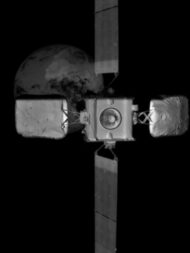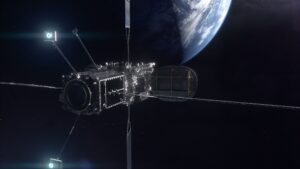The two spacecraft will stay locked together for five years to extend the life of IS-10-02, which was running low on fuel after being in orbit since 2004.
MEV-2 will then undock and move on to a new mission.
“The success of this mission paves the way for our second generation of servicing satellites and robotics, offering flexibility and resiliency for both commercial and government satellite operators, which can enable entirely new classes of missions,” said Tom Wilson, vice president of strategic space systems at Northrop Grumman.

IS-10-02 provides broadband and media distribution services to Intelsat customers across Europe, the Middle East, Africa and South America.
MEV-2 has been performing close proximity operations with the spacecraft since early March, getting close to calibrate and test systems before backing off.
The two companies have come close to attempting to dock several times this past month.
MEV-1, the satellite servicer’s predecessor, successfully attached to another Intelsat satellite last year called IS-901, lifting the sidelined satellite out of GEO graveyard orbit to bring it back into service April 2, 2020.
Intelsat chief services officer Mike DeMarco said: “Space servicing is a valuable tool for Intelsat in extending the high-quality service experience that our customers depend upon.
“Northrop Grumman’s MEV technology has helped us extend the life of two high-performing satellites, while focusing our innovation capital on advancing the Intelsat next-generation network – this technology is a ‘win-win’ for us.”
The U.S. Defense Advanced Research Projects Agency (DARPA) awarded Northrop a contract last year to develop a separate mission robotic vehicle (MRV). Northrop said the MRV will launch in 2024 to carry out repairs and other in-orbit services in addition to relocating satellites.
The MRV is being designed to install mission extension pods (MEPs), which Northrop is also developing, to extend the life of aging satellites.



